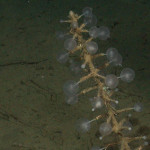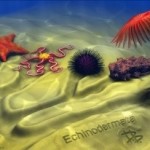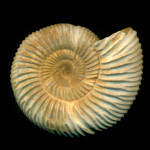This is the third in a series of five referenced articles on the shared characteristics of deep and shallow water corals.
by Michael J. Risk

Image of the Devonian seafloor from “Evolution of Life“
The coelenterates, corals and their relatives, are very ancient, and in fact may be the oldest metazoans. Proterozoic burrows preserved in the Mackenzie Mountains of Northwest Canada were probably made by animals resembling cerianthid anemones, and are about one billion years old. Silurian gorgonians are almost identical to their modern counterparts. The group as a whole has therefore had a very long time to evolve chemical and physical defenses against predation, as well as a wide spectrum of flexible feeding adaptations.
Since the Proterozoic, fossil coelenterates have been fossilized in a wide variety of sedimentary rocks. Reasoning by analogy with the present, paleontologists have usually assumed that these corals lived in shallow water-even though in many cases the depositional environment suggested much deeper water, shelf edge or more. We have now come to understand that many of these occurrences were in fact deep water corals, capable of living in the absence of light.
The earliest European records of deep-water corals come from fishermen in Norwegian waters. Pontoppidan (1755) summarizes the state of knowledge of corals at that time, pointing out that they were used for food and also for “powerful medicines.” These early occurrences almost certainly described Lophelia, which is probably the most widespread coral on the globe. Although the literature devoted to the study of deepwater corals is dwarfed by that of their shallow cousins, there has nonetheless been a steady accumulation of information as to their diversity and occurrence. We owe much of our knowledge of the taxonomy of this large and varied group to the work of Stephen Cairns, at the Smithsonian, who has pointed out that there are approximately as many deepwater corals as there are shallow water corals-with many fewer specialists working on them.
We have known for generations that reef corals can occur in colonies that may be very old, often spanning several centuries. The first hint that deepwater corals might possess extremely long lifespans was the work of Druffel et al. (1995), on the zoanthid Gerardia, for which an age span of 1800 years was estimated. This led Druffel et al. to call Gerardia the “bristlecone pine” of the oceans, after the famous tree of the Sierras that can achieve lifespans of 5000 years.
One of the first things that workers on deepwater corals learn is the scarcity of samples. Reef people can simply put on a mask and snorkel and collect all they need-deepwater coral people either have to scrounge in museum collections or the attics of fishermen, or mount specialized expeditions costing millions of dollars. The potential value of investing money to acquire new samples became apparent with the dawning realization that the secrets of climate change are locked within the skeletons of deepwater corals (eg, Smith et al. 1997). The past decade has seen a virtual explosion of work on this new archive, the value of which increases with the length of the record that can be obtained.
Heikoop et al. (2002) described the lifespans and growth patterns of two deepwater coelenterates, the scleractinian Desmophyllum and the gorgonian Primnoa. The individual corallites constructed by Desmophyllum can potentially live more than a hundred years, but for all intents and purposes obtaining a coherent record of that length from these organisms is impossible. Growth lines are fiendishly close together, the skeleton suffers periods of dissolution on the seafloor, and the isotopic record is bedeviled by disequilibrium effects. Primnoa, on the other hand, was shown to have a lifespan of greater than 300 years. Heikoop et al. suggested that this organism could prove extremely useful in climate studies.


Desmophyllum sp. cup coral live and on-deck in Olympic Coast NMS
Although virtually every deep-sea coelenterate exhibits pronounced growth rings, one of the first steps in the research sequence is to establish the timing of these rings-are they truly annual, or does the organism simply lay down a growth couplet with every environmental disturbance? For further isotopic or trace element data to be useful, the stratigraphy-that is, the ability to date individual rings-must be established. This is why Lophelia will probably never be much good as a climate indicator, even though useful data can be extracted. Its branching growth form means that every chemical analysis needs to be accompanied by a hi-precision radiometric date, and the budget quickly mounts out of sight. If the growth rings in gorgonians and antipatharians are in fact annual, then it will be possible to extract centuries of climate data from one sample.
Fortunately, as in reef corals, the growth rings in gorgonians have been shown to be annual (Sherwood et al., 2005). In this work, rings were counted/estimated visually by several individuals, their answers tabulated and compared with a growth estimate derived using the bomb 14C records in Primnoa. This sets the stage for extraction of huge amounts of paleoclimate data, necessary not only for effective fisheries management but also essential in understanding our climate. One of the reasons that present climate change models are less than perfect is that more than 90% of the data have been taken on 20% of the surface of the earth-we need to move this process into the oceans, and we need many more of the long records that have been shown to be possible.
It now seems highly likely that the bristlecone pines will soon give up their title to the oldest living organisms on the surface of the earth. We have investigated only a small fraction of the world’s deep-sea coral fauna [which is a shame, because this resource is being trawled out of existence on a daily basis] but already some very old specimens have been described. In February, at the AAAS conference in Boston, Brendan Roark, a geochemist from Stanford University, reported a date of 4200 years for a lifespan of a deep-sea coral, a figure that should have bristlecone pines quaking in their roots. At the same conference, it should be noted, Alberto Lindner of the University of Sao Paulo presented genetic evidence suggesting that deepwater corals originated first, and that the shallow corals are descended from them.
We would seem only to be scraping the surface of the potential value of this resource.
References:
Druffel ERM, Griffin S, Witter A, Nelson E, Southon J, Kashgarian, M, Vogel J (1995) Gerardia: Bristlecone pine of the deep-sea? Geochim Cosmochim Acta 59:5031-5036.
Pontoppidan, E. 1755. The Natural History of Norway. A. Linde, London.
Risk, M. J., J. M. Heikoop, M. G. Snow and R. Beukens. 2002. Lifespans and growth patterns of two deep-sea corals: Primnoa resedaeformis and Desmophyllum cristagalli. Hydrobiologia 471: 125-131.
Sherwood, O. A., D. B. Scott, M. J. Risk and T. P. Guilderson. Radiocarbon evidence for annual growth rings in the deep-sea octocoral Primnoa resedaeformis. Mar. Ecol. Progress Series 301: 129-134.
Smith, J. E., M. J. Risk, H. P. Schwarcz and T. A. McConnaughey. 1997. Rapid climate change in the North Atlantic during the Younger Dryas recorded by deep-sea corals. Nature 386: 818-820.
Smith, J. E., H. P. Schwarcz and M. J. Risk. 2002. Patterns of isotopic disequilibrium in azooxanthellate coral skeletons. Hydrobiologia 471: 111-115.






But aren’t the bristlecones very old, singular organisms, whereas the corals are very old colonial organisms? Certainly that would leave the conifer with some bragging rights.
Absolutely, Jason. We are talking about colonial animals. It has been conjectured, actually, that some large old colonies of bamboo corals actually died at some point in the past. The skeletal axis was recolonized by planula larvae, or grown over by parts that survived. It’s kind of a resurrection hypothesis.
Good subject.
So I don’t quite understand the relation between the annual growth rings and being able to determine changes in the climate. I’m writing a thesis for my undergraduate degree on corals and climate change, so this subject is of huge interest to me! I’ve currently been interested in trying to find more research on the presence of corals during time of change in climate throughout history. Do you have any suggestions as to where to look for these kinds of records for shallow or deep water corals if there are any? Thanks!
This is not my specialty, Bridget, but author Mike Risk writes saying this is “an ENORMOUS field, with hundreds of papers. The first was the accidental discovery, by Steve Smith, that hard corals had annual banding. He was working in Bikini, on effects of nuclear weapons testing-had some corals that had been dosed with radioactivity. He decided (why, we will never know) to X-ray them…” Mike recommends papers by Heikoop et al 2002 in Hydobiologia and Edinger et al 2000 in Pollution Bulletin.
I can add that Sr/Ca data analyzed by Secondary Ion Mass Spectrometry (SIMS) suggests temperature might control calcite Sr/Ca ratios in the deep gorgonian Primnoa resedaeformis, so these ratios may be used to reconstruct ocean temperatures. Hopefully someone how knows more will chime in!
Hell again Bridget, It looks like Marine Ecology Progress Series is a good place to go for more info. I just found a paper (Williams et al 2007 MEPS 335:85-95) that cites another paper (Sherwood et al 2005 MEPS 301:135-148) for a strong correlation between apparent oxygen utilization and carbon and nitrogen isotopes, showing gorgonians record surface water processes. Some of these include atmospheric CO2 and in situ carbon production. These isotope values will vary with each annual ring, showing increase, decrease, or steady state conditions over time. Peter
It definatly gives them brag rights and u all r very smrt
We’re doing a piece on the Devonian time period for a class I’m taking and I need some good ideas for our poster we have to make. Got any?
Kelsey, why don’t you try and identify the creatures from the image above that are still alive today, and those that are extinct? Could that be a good project for your poster?
I should have said “…creatures who have ancestors that are still alive today…”